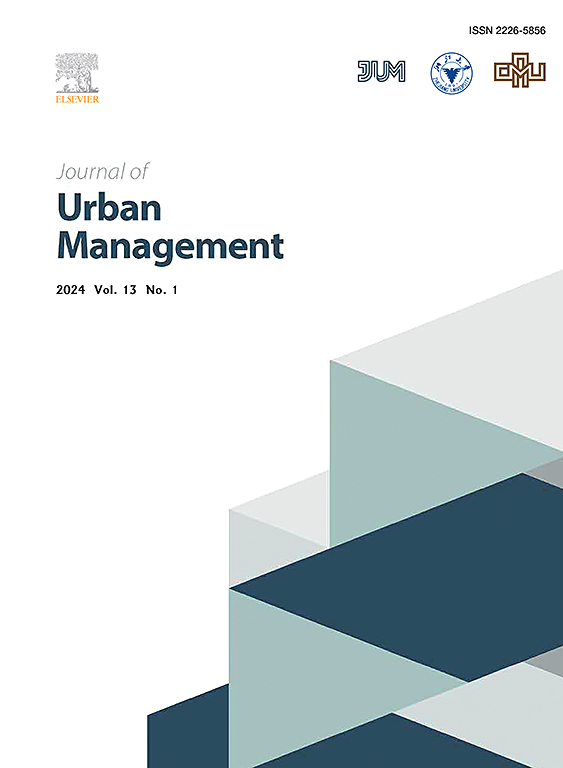摩洛哥 Rehamna 省农村乡镇的农村规划评估和可持续发展潜力
IF 5
2区 社会学
Q1 URBAN STUDIES
引用次数: 0
摘要
农村居住区规划的演变有可能通过调整人类居住区生态系统的组成部分来提高地区的可持续性。在这项研究中,我们在 Rehamna 省(摩洛哥中部)的 23 个农村乡镇促进了可持续性的整合。我们从四个方面对农村发展进行了评估:地理位置和基础设施、资源可用性、经济活动和发展制约因素。这些乡镇根据其占用水平和规划方向分为三类:重要规划区(VPA)、普通规划区(PPA)和初始规划区(IPA)。农村综合发展潜力的最大值、最小值和平均值分别为 0.694、0.176 和 0.429。处于低、中、高水平的乡镇比例分别为 13.04%、60.86%、26.08%。由于区位优势明显,城乡发展一体化程度高,经济发展活力较强,跨越交通轴线、临近水资源的乡镇弥补了本底资源稀缺的缺陷。因此,这些乡镇具有良好的发展潜力。雷哈姆纳省城市发展的第二个主要中心在北部。其空间分布呈现出以中心为核心,逐步向四周扩展的趋势。本文为农村公社提出了一个促进战略性空间规划的框架,为最大限度地发挥农村发展潜力提供了一种新方法。基于这些发现,本文提出了一种新的农村发展空间框架,旨在通过满足农村地区的规划需求来提升其发展地位。本研究为政府、机构、利益相关者和规划者构建有效的农村发展战略提供了一个分析框架,重点关注农村可持续发展所需的基本指标。本文章由计算机程序翻译,如有差异,请以英文原文为准。
Rural planning evaluation and sustainable development potential in rural communes of Rehamna province (Morocco)
The evolution of rural settlement planning has the potential to improve regional sustainability through aligning components of human settlement ecosystems. In this study, we promoted the integration of sustainability in 23 rural communes of Rehamna province (central Morocco). We assessed rural development in four areas: location and infrastructure, resource availability, economic activity, and development constraints. The communes were divided into three categories based on their occupancy levels and planning directions: Vital Planning Area (VPA), Common Planning Area (PPA), and Initial Planning Area (IPA). The rural comprehensive development potential has maximum, minimum, and average values of 0.694, 0.176 and 0.429. The proportion of rural communes in low, medium, and high levels is 13.04%, 60.86%, 26.08%, and correspondingly. Due to their obvious location advantages, high level of integration between urban and rural development, and greater economic development vitality, communes that cross the mobility axe and have proximity to water resources more than make up for the drawback of the scarcity of background resources. As a result, these communes have good development potential. The second main hub of the province of Rehamna's urban development is in the north. The spatial distribution demonstrates the tendency to progressively increase around the center, adopting it as the core. This paper proposes a framework for rural communes to facilitate strategic spatial planning, providing a novel way to maximize rural development potential. Based on these findings, the paper suggests a new spatial framework for rural development that aims to enhance the development status of rural regions by addressing their planning needs. This study presents an analytical framework for government, institutions, stakeholders, and planners to construct effective rural development strategies, focusing on the essential indicators required for rural sustainability.
求助全文
通过发布文献求助,成功后即可免费获取论文全文。
去求助
来源期刊

Journal of Urban Management
URBAN STUDIES-
CiteScore
9.50
自引率
4.90%
发文量
45
审稿时长
65 days
期刊介绍:
Journal of Urban Management (JUM) is the Official Journal of Zhejiang University and the Chinese Association of Urban Management, an international, peer-reviewed open access journal covering planning, administering, regulating, and governing urban complexity.
JUM has its two-fold aims set to integrate the studies across fields in urban planning and management, as well as to provide a more holistic perspective on problem solving.
1) Explore innovative management skills for taming thorny problems that arise with global urbanization
2) Provide a platform to deal with urban affairs whose solutions must be looked at from an interdisciplinary perspective.
 求助内容:
求助内容: 应助结果提醒方式:
应助结果提醒方式:


